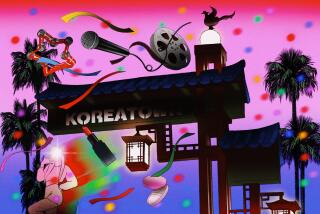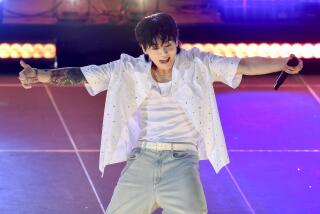South Korean Arts Showcase : Culture: Tonight’s ‘Millennia’ program at Shrine Auditorium offers a sample of music and dance.
- Share via
History was made Tuesday when the United Nations admitted North and South Korea as full voting members, ending a 40-year Cold War stalemate over the issue.
But that does not mean the two countries have begun to end their differences, politically or artistically.
“All (North Korean) art has been modified to make it more politically motivated,” says Jeong-Yoop Park, executive director of the International Cultural Society of Korea, which is presenting “The Sound of Millennia: A Gala Evening of Korean Music and Dance,” on tonight1) at 7:30 at the Shrine Auditorium.
“There is nothing (classical) left there because it is considered imperialistic and feudalistic,” Park said. On the other hand, “The music and dance (of South Korea) have been kept in pure form. No political ingredients have been artificially inserted . . . .”
Local audiences may be able to judge for themselves if a touring group from North Korea, tentatively scheduled to depart in late October, actually arrives. “But it’s not confirmed,” Park said. “If they do come, I think people will see a real contrast between their art and ours.”
Until then, they will have to rely upon the “Millennia” program, which actually had been planned a year before the U.N. membership issue was resolved. “When the membership came up, we thought it was a good idea to organize our previously planned performance around this event,” Park said.
The two-part program will range from instrumental court music, including a duet on the “Five Cardinal Virtues” described by Confucius, to folk songs and dances, including a “Thousand Ways of Drumming” Buddhist monk dance.
“The first part will be quiet and full of serenity,” said Yongchol Won, director of the Korean Cultural Center in Los Angeles, sponsor of the local leg of the tour. “But the second part is dynamic and very exciting.”
The idea, Park said, is to present a broad spectrum of traditional art. Participating will be 136 Korean musicians, singers and dancers, including several artists designated as “Human Cultural Treasures.”
After Los Angeles, the program will move to New York and then to several Eastern European countries (Poland, Yugoslavia and Czechoslovakia), as well as to the Soviet Union--the very country which had blocked the South’s admission to the United Nations on five separate occasions.
Park is especially hopeful that that the program here will attract a Western audience as well as ome of the approximately 350,000 Koreans who live in Southern California, according to Craig Coleman, executive director of the Korea Society.
“This is definitely the largest community of Koreans in the United States and outside of Asia,” Coleman said. “Yet many of us don’t know who these Korean people are and what their culture really is all about. This program will help answer those questions.”
More to Read
The biggest entertainment stories
Get our big stories about Hollywood, film, television, music, arts, culture and more right in your inbox as soon as they publish.
You may occasionally receive promotional content from the Los Angeles Times.










